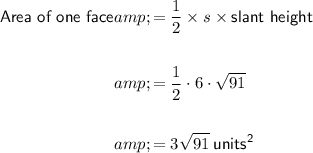Answer:
Lateral surface area =
 units²
units²
= 171.71 units²
Explanation:
Lateral area: total surface area excluding its base
Find the radius (circumradius) of the regular hexagonal base. Use this to find the slant edge of the pyramid, then use the slant edge to find the slant height and thus the area of each face.
Radius of a regular polygon: distance from its center to its vertices.

where:
- s = side length
- n = number of sides
Given:

Use Pythagoras' Theorem to find the slant edge:

Use Pythagoras' Theorem to find the slant height:


